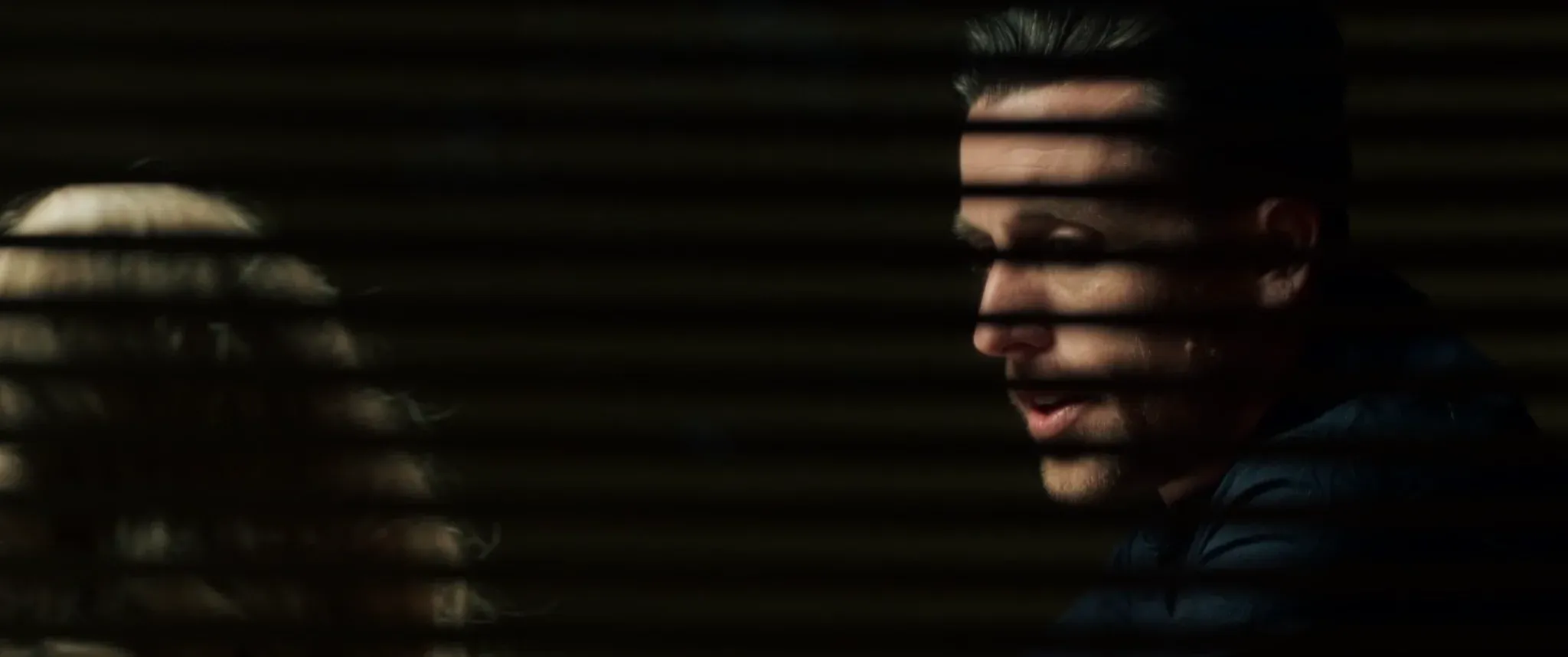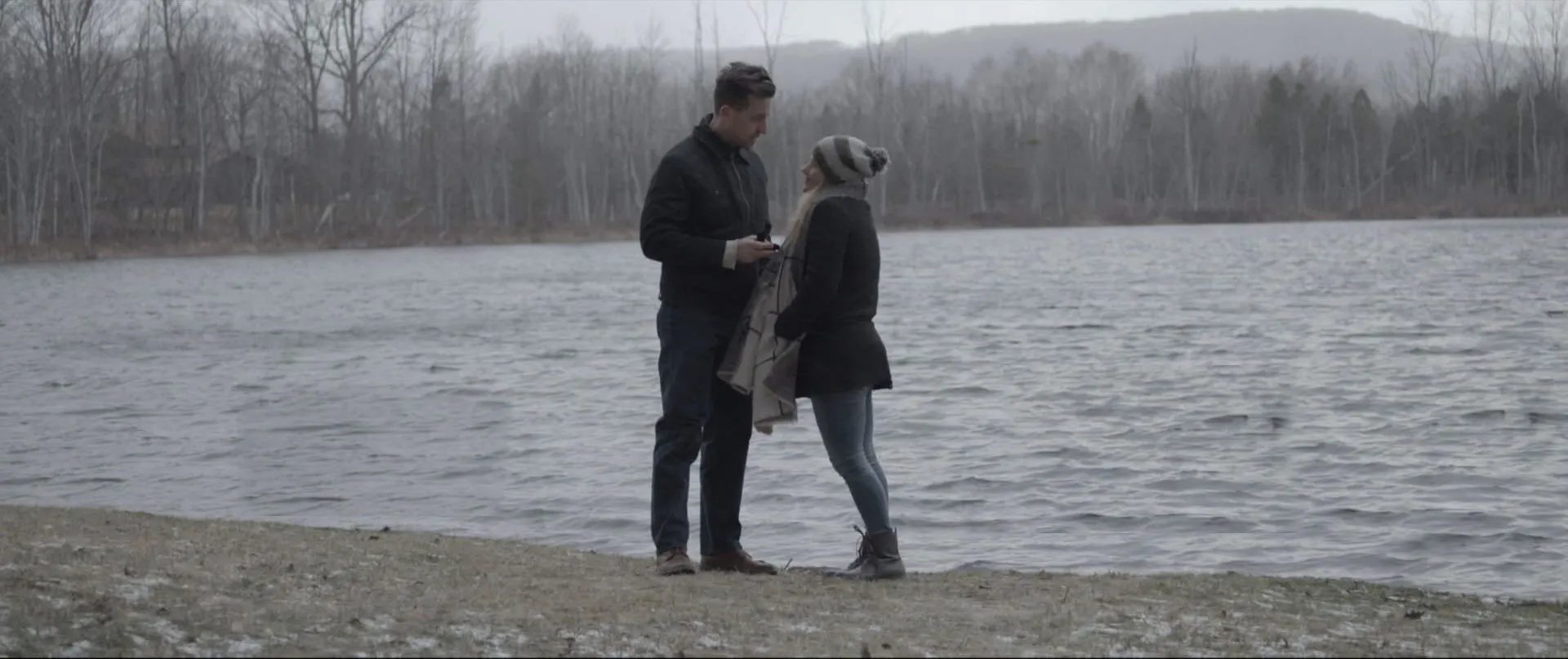Scarlet Winter emerges as a psychological thriller set within a cold, foreboding landscape where ice and isolation mirror human disquiet. The film unfolds its narrative through a twisting, fragmented timeline that invites viewers to question every moment. A chilling atmosphere pervades each scene, with a muted color palette and stark visuals that capture a world stripped of warmth.
Mark, the central character, finds himself plunged into terror upon awakening beside the lifeless body of his lover. His ordeal forms the core of the narrative, where personal relationships fray under the pressure of secrecy and heartache. His faltering marriage with Sidney and the dangerous liaison with Naomi provide intricate layers of domestic conflict. The predicament forces him into a murky moral territory where every choice carries heavy consequences.
The winter setting plays a significant role, its relentless cold and barren vistas intensifying the film’s emotional charge. This ambiance not only informs the visual storytelling but also harmonizes with the non-linear structure, gradually revealing hidden motives and forgotten memories. Scarlet Winter invites international audiences to appreciate a style that intersects cinema traditions from distant lands, forging connections with the storytelling approaches seen in parallel Indian narratives and global cinematic movements.
Fragmented Timelines and Tension Building
The film’s structure employs a non-linear approach that artfully mixes past and present, inviting a fresh look at the unfolding drama. Starting in the midst of action, Mark’s sudden encounter with a grisly scene—his discovery of a lifeless body and a stark weapon—throws viewers directly into the chaos of his troubled existence. This opening moment instantly creates a sense of uncertainty that carries through the entire film.
Scarlet Winter opts for an arrangement that interweaves flashbacks with present events. These shifts interlace Mark’s personal history, from his missteps and fractured personal life to the rising tension in his relationships with Sidney and Naomi.
The approach runs the risk of disorienting the audience, yet it offers the benefit of slowly revealing the underlying motives and hidden conflicts. In a manner reminiscent of approaches seen in various international film styles, this technique captures the attention of viewers who appreciate narratives presented in a scattered order.
Beginning in medias res, the film throws audiences immediately into the turmoil of Mark’s predicament. The interruptions in the timeline, characterized by abrupt shifts to earlier episodes, serve to heighten engagement. These time shifts require viewers to piece together clues from multiple moments, building a layered understanding of the events that led to the initial shock.
Depth in Disorder: Character Dynamics and Paradoxes
Mark, as the film’s focal point, is portrayed as a man whose mental state deteriorates under immense pressure. His path from initial shock to a state marked by persistent worry and uncertainty is a central driver of the narrative. His expressions of confusion and inner unrest are captured through subtle facial cues and deliberate camera angles, which invite the viewer to consider his growing sense of isolation. The portrayal of his internal strife raises questions about his role: is he simply caught in an uncontrollable sequence of events, or does his own conduct contribute to the unraveling he experiences?
Sidney, the wife caught in a turbulent domestic situation, triggers much of the unfolding drama. Her presence not only brings hidden secrets to light but also signifies a rupture in the marital fabric that has long been strained. Her actions—labeled by hints of betrayal and emotional overload—set off a chain reaction that intensifies the narrative’s dramatic pace. Sidney’s portrayal is marked by a stark intensity, reflecting a persona that oscillates between vulnerability and defiance.
Naomi, whose fate sparks the mystery, represents the enigma at the heart of the plot. Even if her character seems fleeting, her impact is felt throughout Mark’s psychological deterioration. Her brief appearances are underscored by symbolic imagery that hints at a life of unrest and unfulfilled desires, making her presence a potent marker for the film’s exploration of forbidden liaisons.
Supporting characters, such as Richie, play pivotal roles in complicating Mark’s predicament. Richie’s involvement is captured through moments of conflicted loyalty and moral hesitation. Minor figures, although possessing limited screen time, contribute additional strands of suspicion that layer the film’s narrative. The interactions among these characters create moments filled with tension, as concealed motives and shared missteps come to light in a narrative replete with unexpected disruptions.
Frigid Cinematic Artistry: A Visual Critique of Scarlet Winter
Scarlet Winter presents a visual experience that uses snowy, barren landscapes to mirror the inner chill experienced by its characters. The film employs a restrained palette focused on cool blue and crisp white tones, creating an environment where the cold seems to seep into every frame. The stark nature of the settings reflects the isolation and tension permeating the narrative, much like the carefully composed shots found in notable works from both Bollywood parallel cinema and world cinema.
The use of subdued lighting paired with sharp shadows intensifies the moody atmosphere. Dim areas of the screen contrast with sudden bursts of brightness, a technique that captures the unpredictable nature of the unfolding drama. In several scenes, faces are partially obscured by darkness, leaving viewers to read emotions from slight movements and subtle expressions. This method reminds one of classical techniques employed in Indian artistic films where lighting serves as a silent narrator.
The camera work oscillates between fluid, kinetic movements in moments of high anxiety and deliberate, fixed frames during scenes of internal conflict. Instances featuring close-up views highlight the nuanced expressions of characters caught in moments of crisis, while wide shots reveal the desolation of a winter landscape that surrounds them. Specific compositions, such as shots that position characters against expansive, empty spaces, reinforce feelings of vulnerability and isolation.
Recurring visual elements, including glossy ice surfaces and blurred reflections, serve as powerful symbols throughout the film. These images consistently contribute to a story that unites non-linear plot fragments into a consistent visual narrative. The artistic choices made in the framing and staging of each scene create a visual dialogue that echoes trends seen in global cinema, connecting techniques from classic Bollywood narratives with international stylistic innovations.
Resonant Soundscapes: Sonic Architecture and Pacing
Scarlet Winter uses its sound to heighten the sense of unease throughout the film. The musical score, with its persistent, low-key motifs, adds to the feeling of apprehension. A measured tempo in the score matches the moods shown on screen, with recurring themes that subtly mirror Mark’s inner unrest and the obscured secrets within his life. Soft ambient noises, layered with intermittent eerie tones, contribute to a mood that never feels static, keeping viewers alert and engaged.
The editing also plays a key role in shaping the narrative’s auditory impact. Careful transitions mark shifts between time periods, ensuring that each period flows smoothly into the next. During moments when the action peaks, rapid cuts combine with abrupt changes in the soundtrack, effectively driving tension and uncertainty. In quieter moments, lingering shots paired with minimal sound invite the audience to absorb the weight of the unfolding events. The sound elements, coordinated with visual storytelling, form a cohesive experience that strengthens the film’s themes of isolation and suspicion.
Icy Mirrors: Themes and Symbols in Scarlet Winter
Scarlet Winter presents relationships tainted by betrayal and unfaithfulness. Marital discord and hidden liaisons drive personal ruin throughout the film. Mark’s life unravels as past transgressions return to haunt him and his companions. His inner struggle reflects an emotional burden that spills over into every encounter. On screen, strained connections reveal secrets that split intimate bonds, leaving characters to confront the weight of guilt and regret. The personal cost of broken promises stands at the forefront.
The narrative paints a picture of fractured trust, where suspicion infiltrates every scene. Characters often face situations where uncertainty clouds their judgment. Instances of disrupted memories and ambiguous flashbacks emphasize that the truth is shrouded in complexity. A sense of mistrust arises from uncertainty, prompting the audience to question whose version of events can be believed. This ambiguity enriches the narrative with a mood marked by relentless apprehension.
Winter becomes more than just a backdrop. The biting cold and barren landscapes act as symbols of isolation, conveying characters’ internal emptiness. Visual cues such as glistening ice surfaces and mirrored imagery, alongside somber musical cues, heighten the film’s focus on emotional desolation. Every element reinforces the notion that the environment mirrors the characters’ inner states.
Fragments of narrative scattered across time create a feeling of confusion, echoing the disarray of a troubled mind. Such storytelling reflects a style familiar to Indian parallel cinema, where non-linear narratives are often used to challenge conventional storytelling. The focus on self-identity and the consequences of irreversible decisions prompt viewers to examine the cost of choices made in desperation. Every visual and auditory element contributes to a rich commentary on the nature of truth, as observed through the lens of personal failure and internal strife.
Full Credits
Director: Munjal Yagnik
Writer: Munjal Yagnik
Cast: Gregory Waits, Sophie Moshofsky, Nadine van Asbeck, Ryan Hope Travis, Jeff White, Katia Yagnik
The Review
Scarlet Winter
Scarlet Winter challenges its audience with a complex narrative and stirring visuals. The fractured timeline and emotionally charged performances combine to deliver a thought-provoking experience, even if some plot elements feel disconnected. The film’s portrayal of personal strife amidst stark, wintry backdrops and its careful use of sound and imagery offer a deep, if enigmatic, look at troubled relationships. The movie holds a distinct appeal for fans of daring storytelling and visual experimentation.
PROS
- Striking visuals and atmospheric set design
- Bold narrative structure with non-linear elements
- Powerful sound design that heightens tension
- Strong, effective lead performances
- Well-crafted use of cinematic symbolism
CONS
- Narrative complexity can feel overly disjointed
- Pacing may cause moments of disengagement
- Some character arcs lack depth
- Plot fragments remain unresolved


















































